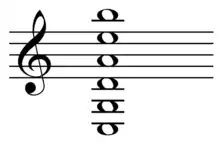In the theory and practice of music, a fifth interval is an ordered pair of notes that are separated by an interval of 6–8 semitones.
There are three types of fifth intervals, namely
- perfect fifths (7 semitones),
- diminished fifth (6 semitones), and
- augmented fifth (8 semitones).
After the unison and octave intervals, the perfect fifth is the most important interval in tonal harmony. It is highly consonant. Its implementation in equal temperament tuning is highly accurate, unlike the major third interval, for example. As explained below, it is used to generate the chromatic circle and the cycle of fifths, and it is used for tuning string-instruments. It is a constituent interval for the fundamental chords of tonal harmony.
Tonal harmony
The fundamental chords of tonal music—major and minor triads and also seventh chords—all contain fifth intervals.
- Perfect fifths are contained in major and minor triads and in particular seventh chords (especially major-minor sevenths with dominant function, major sevenths, and minor sevenths).
- Diminished fifths are contained in diminished triads and in half-diminished sevenths and fully diminished seventh chords.
Fifths are stacked to form chords in quintal harmony.
Cycle of fifths

Concatenating the perfect fifths ((F, C), (C, G), (G, D), (D, A), (A, E), (E, B),...) generates the sequence of fifths (F, C, G, D, A, E, B, F♯, ...); this sequence of fifths displays all twelve notes of the chromatic circle.[2]
Harmonization of scales in fifths
Major scale on C
All but one of the intervals are perfect fifths. The (b, f) interval is a diminished fifth.

Tuning of instruments

All-fifths tuning refers to the set of tunings for string instruments in which each interval between consecutive open strings is a perfect fifth. All-fifths tuning is the standard tuning for mandolin and violin and it is an alternative tuning for guitars. All-fifths tuning is also called fifths, perfect fifths, or mandoguitar tuning.[3]
References
Notes
- ↑ McCartin (1998, p. 364): McCartin, Brian J. (November 1998). "Prelude to musical geometry". The College Mathematics Journal. 29 (5): 354–370. doi:10.1080/07468342.1998.11973971. JSTOR 2687250.
- ↑ This sequence of fifths features the diminished fifth (b, f), which replaces the perfect fifth (b, f♯) containing the chromatic note f♯, which is not a member of the C major key. The note f (of the C major scale) is replaced by the note f♯ in the Lydian chromatic scale (Russell 2001, "The fundamental harmonic structure of the Lydian scale", Example 1:7, "The C Lydian scale", p. 5). Russell, George (2001) [1953]. "Chapter 1 The Lydian scale: The seminal source of the principal of tonal gravity". George Russell's Lydian chromatic concept of tonal organization. Vol. One: The art and science of tonal gravity (Fourth (Second printing, corrected, 2008) ed.). Brookline, Massachusetts: Concept Publishing Company. pp. 1–9. ISBN 0-9703739-0-2.
- ↑ Sethares, Bill (2001). "Regular tunings". Alternate tuning guide (PDF). Madison, Wisconsin: University of Wisconsin; Department of Electrical Engineering. pp. 52–67. 2010 Alternate tuning guide, including a revised chapter on regular tunings. Retrieved 19 May 2012.
Bibliography
- Clendinning, Jane Piper; Marvin, Elizabeth West (2005). The musician's guide to theory and analysis (First ed.). New York: W. W. Norton and Company. ISBN 0-393-97652-1.
- Duckworth, William (2007). A creative approach to music fundamentals: Includes keyboard and guitar insert (ninth ed.). 2005928009: Thomson Schirmer. pp. 1–384. ISBN 978-0-495-09093-9.
{{cite book}}: CS1 maint: location (link) - Kostka, Stefan; Payne, Dorothy; Almén, Byron (2013). Tonal harmony with an introduction to twentieth-century music (seventh ed.). New York: McGraw-Hill. ISBN 978-0-07-131828-0.
- Persichetti, Vincent (1961). Twentieth-century harmony: Creative aspects and practice. New York: W. W. Norton. ISBN 0-393-09539-8. OCLC 398434.